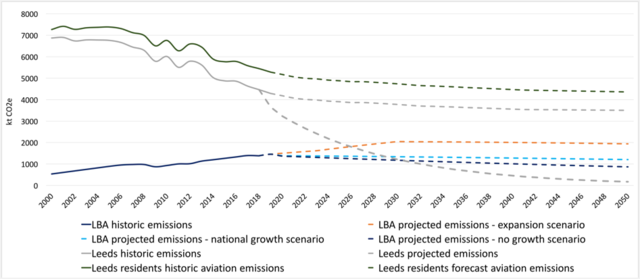Aviation emissions from Leeds pose “major challenge” for decarbonisation of city
18th December, 2019 - 00:01

Leeds Climate Commission has produced a position paper examining the impact of aviation on Leeds’ current and future carbon emissions to help guide the city’s response to the climate emergency.
The evidence-based paper, published today, sets the growing emissions from flights taken by Leeds residents, and those from Leeds Bradford Airport, in the context of a carbon roadmap for Leeds and the city’s adoption of a 2030 “net zero” carbon target.
The position paper represents the first such attempt to address the complicated issue of aviation’s contribution to a UK city’s carbon budget. Aviation emissions are not currently included in the UK’s carbon budgets, or in other city-level analyses, making Leeds a leader in starting to address this major challenge.
It calls for a national aviation strategy to support the coordinated delivery of measures first to limit and then to offset the impacts of aviation emissions. It also explores the possible impact of a raft of measures from taxes to tree-planting which might in theory reduce and/or offset emissions from flights to or from Leeds Bradford Airport. Whilst recognising some scope for local action, it stresses the need for national policy changes to allow these measures to actually be adopted.
The paper, which has been in preparation since August 2019, follows a recommendation from the Leeds Citizens’ Jury on climate change that was made independently in November 2019 that the expansion of Leeds Bradford Airport to be stopped.
Airport expansion - a major challenge in need of a national strategy
Currently aviation is responsible for 7% of the UK’s total greenhouse gas emissions – with its share of emissions forecast to grow to 25% by 2050 as other emissions (e.g. from electricity generation) fall.
Aviation is a major sector and a significant employer, both nationally and regionally, and all UK airports have plans to expand. Leeds Bradford Airport plans to expand from 4m to 7m passengers a year by 2030, whilst Manchester could expand from 28m to 50m passengers a year by 2030 and Heathrow from 80m to 130m by 2028.
The paper argues that such expansions in flying represent a very significant challenge given the need to deliver deep reductions in carbon emissions in the next decade in response to the climate emergency.
In a context where all airports have significant growth plans, joined-up action is clearly required. An ambitious national aviation strategy that integrates aviation into the national carbon roadmap and supports measures to limit and offset aviation emissions in a coordinated way is needed, says the paper.
As well as emphasising the need for a national policy response, the paper examines the impact of flights on Leeds’ carbon roadmap and it reviews the evidence on some of the actions that could be taken to reduce aviation emissions.
Aviation emissions: who is responsible?
Calculating the contribution of emissions from aviation at the city scale is complex because an accepted methodology has yet to be widely adopted and because it raises some complex issues about who should have responsibility for emissions from flying.
Responsibility for the emissions from flights could be allocated to different actors (the airport, the airlines, the passengers), to different areas (the area where the airport is located, where passengers come from or the destinations they are travelling to) or to different levels (locally, regionally, nationally, internationally). In practice, responsibility is shared and a coordinated response is required.
Although around 18% of flights from Leeds Bradford Airport are taken by residents of Leeds, Leeds residents take many more flights from other airports, and the emissions from these should also be accounted for in an assessment of the city’s carbon footprint.
Similarly, although Leeds Bradford Airport falls within the city boundaries of Leeds, an estimated 82% of its passengers come from outside of the city, with around 72% coming from other parts of the Yorkshire and Humber region. Some of the responsibility for the emissions arising from Leeds Bradford Airport should be attributed to other parts of the region.
How aviation emissions affect Leeds’ carbon roadmap
The position paper assesses the impact of aviation emissions on the Leeds Carbon Roadmap, which was originally published by the Leeds Climate Commission on 10 April 2019. This shows what would happen to city-scale emissions if Leeds continues with business-as-usual, or – as is recommended – if it delivers on science-based targets to reduce its emissions from all of the fuel (e.g. petrol, diesel, gas) and electricity used within the city.
Adding emissions from flights taken by Leeds residents from any airport to the emissions from fuel and electricity used within Leeds would see a 21% increase in the city’s emissions.
To illustrate the scale of the challenge, the paper notes that if responsibility for all flights from Leeds Bradford Airport were allocated to Leeds, then with expansion from 4m to 7m passengers a year by 2030, emissions from all flights to and from the airport would be the same as Leeds’ total emissions from its consumption of all fuels and electricity by 2026.
The figure above shows the impact (historical and projected) of aviation emissions from flights made by Leeds residents on the Leeds Carbon Roadmap.
In the shift from the grey to the green line, it shows what happens to Leeds’ carbon footprint when emissions from flights taken by Leeds residents are added in.
In the dark blue line with three coloured dotted lines going into the future, it also shows the scale of emissions from all flights taken from Leeds Bradford Airport under three growth scenarios.
Low carbon aviation?
In response to the challenges raised, the position paper considers the potential impact of a range of measures that could be adopted to influence aviation emissions, suggesting that it could in theory be possible to reduce the impacts of flights and offset emissions, including from Leeds Bradford Airport.
As an illustration of what might be done, the paper explores what would happen to emissions if flights to destinations that could be reached by train could be restricted through national policy changes and voluntary commitments to reduce flying could be promoted through national or local initiatives. It also considers the impact of a frequent flyer tax of £8.50 per flight aimed at a small proportion of passengers in high income groups (nationally, 20% of people take 70% of flights in a year). Such a tax could only be adopted through national policy.
Together, these measures might reduce flight based emissions by 22%, but if the revenue from a tax was used to improve the energy performance of houses and other buildings in Leeds then this emissions cut could almost double. Again the recycling of a frequent flyer tax to fund local or regional projects could only happen with the support of national policy.
Finally, it assesses whether a regional tree planting scheme could be funded by the frequent-flyer tax to offset remaining flight-related emissions. Were this to happen, it finds that even if all of the other actions mentioned above were taken first, off-setting the remaining flight based emissions from Leeds Bradford Airport through to 2050 would require 360 million trees to be planted in the next decade, requiring a land area equivalent to one and a half times the size of Leeds.
Measures to reduce emissions by improving the fuel efficiency of planes, or adopting better air traffic management practices were also examined but are likely to be cancelled out by forecast increases in passenger numbers. Alternative technologies for aviation (such as electric or biofuel powered planes) could become viable, but wider challenges (such as where the electricity or biofuels come from) remain. The paper states that there is little prospect for the widespread adoption of new technologies or fuels in the next decade, but of course there is scope for such innovations to be better supported through national or international policy.
Leeds leads the way
Commenting on the position paper, Professor Andy Gouldson, Chair of Leeds Climate Commission, said:
“Leeds has taken an important step in showing the impact of aviation emissions on the city’s carbon budget. This hasn’t been done for any other UK city, and it’s not currently included in national carbon accounting either. It needs to be.
“It’s not straightforward to calculate but whichever way you do it, the paper shows that emissions from flying present a major challenge.
“Even if we work very hard to do everything else to respond to the climate emergency and to reach net zero emissions by 2030, we won’t achieve the overall emissions reductions needed without tackling flying.
“We concluded that to do that a national aviation strategy is needed. While local government has some influence over airport expansion – relating to the buildings, air or noise quality, or local surface transport connections – the main policy levers that could be used to address the situation are only available at the national level, and will require a coordinated approach across the UK as well as international co-operation.
“We have taken a positive approach in this paper, demonstrating that there are also local initiatives and voluntary measures that could be deployed to reduce aviation emissions. These would also improve the city, people’s homes, their health and the environment.”
The evidence-based position paper is intended to inform and guide the city’s response to the climate emergency. It was produced by Leeds Climate Commission but the views expressed cannot be attributed to any single member.


